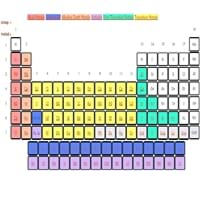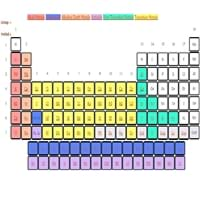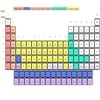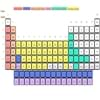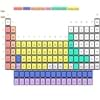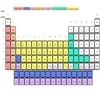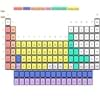Neptunium vs Promethium
Periodic Table
Symbol
Np
Pm
Group Number
Not Available
Not Available
Period Number
7
6
Block
f block
f block
Element Family
Actinide
Lanthanide
CAS Number
7439998
99+
7440122
99+
Space Group Name
Pnma
Not Available
Space Group Number
62.00
11
Not Available
Facts
Interesting Facts
Not Available
- Promethium metal found in Pitchblende.
- Promethium metal is highly radioactive metal.
Sources
Made by Bombarding Uranium with Neutrons, Ores of metals
Found in Minerals, Mining
History
Who Discovered
Edwin McMillan and Philip H. Abelson
Chien Shiung Wu, Emilio Segrè, Hans Bethe
Discovery
In 1940
In 1942
Abundance
Uses
Uses & Benefits
- Currently known uses of Neptunium metal are limited to research purpose only.
- Neptunium’s isotope neptunium-237 is used as a neutron detectors.
- It is used for research purpose. Very small amount of this metal is used in atomic batteries.
- Its radioactive decay is used for a phosphor to give off light. The light emitted is converted into electricity.
Industrial Uses
NA
NA
Medical Uses
NA
NA
Other Uses
Alloys, Nuclear Research, Research Purposes
NA
Biological Properties
Toxicity
Toxic
Non Toxic
Present in Human Body
No
No
In Blood
0.00 Blood/mg dm-3
37
0.00 Blood/mg dm-3
37
In Bone
0.00 p.p.m.
36
Not Available
Physical Properties
Melting Point
640.00 °C
99+
1,042.00 °C
99+
Boiling Point
3,902.00 °C
13
3,000.00 °C
31
Appearance
Physical State
Solid
Solid
Color
Silver
Unknown
Luster
Metallic
Metallic
Hardness
Speed of Sound
Not Available
Not Available
Optical Properties
Allotropes
No
No
α Allotropes
Not Available
Not Available
β Allotropes
Not Available
Not Available
γ Allotropes
Not Available
Not Available
Chemical Properties
Chemical Formula
Np
Pm
Isotopes
Known Isotopes
20
19
27
12
Electronegativity
Pauling Electronegativity
1.36
29
Not Available
Allred Rochow Electronegativity
1.22
26
1.07
32
Electropositivity
Pauling Electropositivity
2.64
25
Not Available
Ionization Energies
1st Energy Level
604.50 kJ/mol
99+
540.00 kJ/mol
99+
2nd Energy Level
1,128.00 kJ/mol
99+
1,050.00 kJ/mol
99+
3rd Energy Level
1,997.00 kJ/mol
99+
2,150.00 kJ/mol
99+
4th Energy Level
3,242.00 kJ/mol
99+
3,970.00 kJ/mol
38
Electrochemical Equivalent
1.77 g/amp-hr
39
1.80 g/amp-hr
36
Electron Work Function
Not Available
Not Available
Other Chemical Properties
Ionization, Radioactive Isotopes, Radioactivity, Solubility
Ionization, Radioactive Isotopes, Solubility
Atomic Properties
Atomic Number
93
25
61
99+
Electron Configuration
[Rn] 5f4 6d1 7s2
[Xe] 4f5 6s2
Crystal Structure
Orthorhombic (ORTH)
Double Hexagonal Close Packed (DHCP)
Crystal Lattice
ORTH-Crystal-Structure-of-Neptunium.jpg#100
DHCP-Crystal-Structure-of-Promethium.jpg#100
Atom
Number of Protons
93
25
61
99+
Number of Neutrons
144
14
84
40
Number of Electrons
93
25
61
99+
Radius of an Atom
Atomic Radius
155.00 pm
30
183.00 pm
10
Covalent Radius
190.00 pm
18
199.00 pm
12
Van der Waals Radius
221.00 pm
22
236.00 pm
16
Atomic Weight
237.00 amu
22
145.00 amu
99+
Atomic Volume
11.62 cm3/mol
99+
22.39 cm3/mol
12
Adjacent Atomic Numbers
Valence Electron Potential
96.00 (-eV)
9
44.10 (-eV)
39
Lattice Constant
666.30 pm
3
Not Available
Lattice Angles
π/2, π/2, π/2
Unknown
Lattice C/A Ratio
Not Available
Not Available
Mechanical Properties
Density
Density At Room Temperature
19.38 g/cm3
14
7.26 g/cm3
99+
Tensile Strength
125.00 MPa
14
Not Available
Viscosity
Not Available
Not Available
Vapor Pressure
Vapor Pressure at 2000 K
0.11 (Pa)
17
Not Available
Elasticity properties
Shear Modulus
Not Available
18.00 GPa
36
Bulk Modulus
Not Available
33.00 GPa
36
Young's Modulus
Not Available
46.00 GPa
38
Poisson Ratio
Not Available
0.28
17
Other Mechanical Properties
Ductile
NA
Magnetic Properties
Magnetic Characteristics
Specific Gravity
20.25
6
7.26
99+
Magnetic Ordering
Paramagnetic
Paramagnetic
Electrical Properties
Electrical Property
Conductor
Conductor
Resistivity
1.22 nΩ·m
99+
0.75 nΩ·m
99+
Electrical Conductivity
0.01 106/cm Ω
99+
Not Available
Electron Affinity
Not Available
50.00 kJ/mol
21
Thermal Properties
Specific Heat
0.12 J/(kg K)
40
0.18 J/(kg K)
33
Molar Heat Capacity
29.46 J/mol·K
8
Not Available
Thermal Conductivity
6.30 W/m·K
99+
17.90 W/m·K
99+
Critical Temperature
Not Available
Not Available
Thermal Expansion
Not Available
9.00 µm/(m·K)
99+
Enthalpy
Enthalpy of Fusion
3.20 kJ/mol
99+
7.50 kJ/mol
99+
Enthalpy of Atomization
Not Available
310.00 kJ/mol
34
Standard Molar Entropy
Not Available
Not Available
|
||
|
||
|
